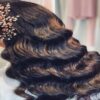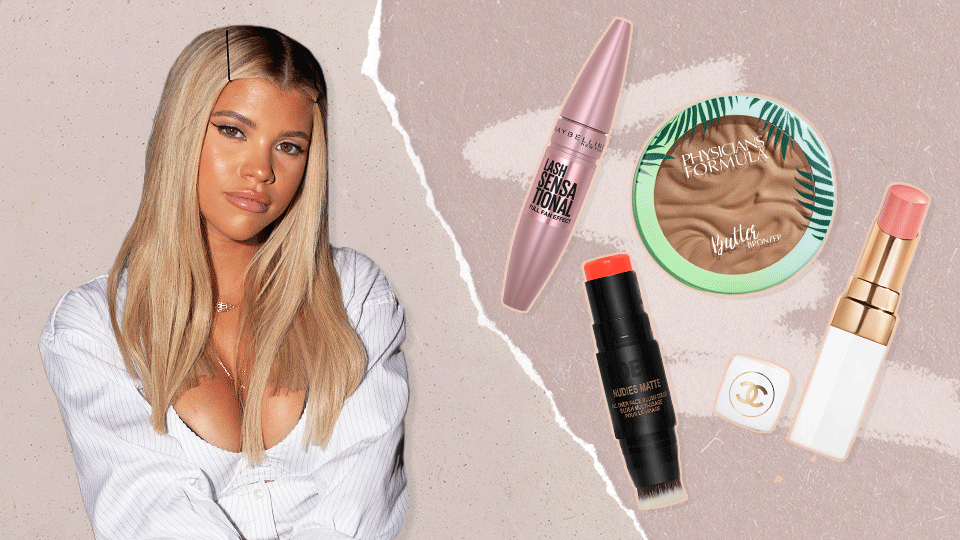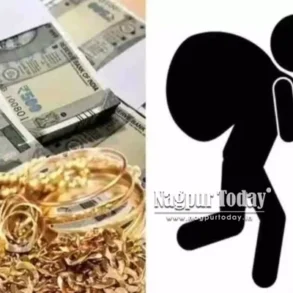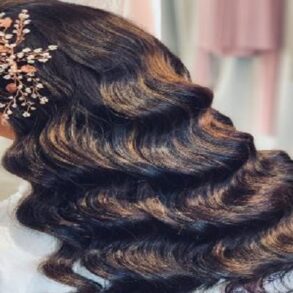If you search “slicked-back bun” in TikTok, you’ll get close to 600 million results. It’s not just a celebrity-favorite hairstyle. The girlies love the look for day or night. But it turns out, the style might not love you back. In fact, it’s possible slicked-back hair causes hair loss, but don’t stress. If you can’t live without pulling your strands back into a ponytail or a bun, there are a few ways to keep from going bald. (Sorry.)
Recently, Sofia Richie Grainge‘s slicked-back bun tutorial went viral on the app. She calls it her “sleek lazy girl bun.” Let us give you a quick run-down. On clean, wet hair, she applies a ton of a protein-enriched hair mask. Seriously, she soaks her hair in it. Then, she adds some cream and sections her strands, tying off one part with a thin elastic. She finishes by tightly pulling back the rest of her hair and secures the bun with another elastic. “Because it started wet, it is so secured onto your head,” she says. She finishes with more cream and hair oil for shine.
She looks gorgeous. There’s no doubt. So do Bella Hadid, Kim Kardashian, and Hailey Bieber when they do a slicked-back hairstyle. But there are some major red flags with the way Grainge does her version. The first one is tying your hair back at all — especially this tight — while it’s wet.
“Wet hair is more vulnerable as it stretches more, and the cuticle is not as strong as when it’s dry,” says NYC hairstylist and certified trichologist, Shab Caspara. “Repeated tension to the hair cuticle can cause micro-tears, with possibility for traction alopecia, which is a type of hair loss caused by continued tension in the same area. Baby hairs and chemically treated hair are especially at risk.” Yup, we’re looking at you, bleach blondes.
Helen Reavey, board-certified trichologist, hairstylist, and founder of Act+Acre agrees. “In addition to potential damage, split ends and breakage, continuously putting the hair in tight hairstyles like slick-back buns can also cause traction alopecia, which occurs when the hair follicles are gradually pulled, resulting in thinning or bald patches, especially around the hairline and temples,” she says. This is true for wet or dry hair.
“Consistently styling your hair in tight hairstyles can put excessive stress on the hair, leaving it more prone to breakage and scalp irritation,” Reavey adds. “Doing this style once a week or once every two weeks is totally okay, but if you’re doing it daily it can actually lead to hygral fatigue. This occurs when excessive moisture penetrates the hair, causing repeated swelling and damage to the hair follicles.”
Black women have known about traction alopecia forever, as many protective styles, extensions, and wigs, can cause that hair loss, especially around the temples. As more and more hair types try tight, slicked-back hairstyles, it’s becoming even more prevalent on more hair types.
Sadly, that’s not the only issue with Grainge’s tutorial. It’s the hair mask. Now, the one she uses is great for your hair when you follow the directions on the packaging. But leaving a “reparative,” bond-building mask in for too long can do more harm than good. That’s why Reavey recommends using a strictly hydrating mask if you’re going to keep it in for a long time. Look for moisturizing ingredients and butters. “If you do add a hair mask to your sleek back bun, always ensure to rinse it out at the end of the day,” she adds.
In addition to putting too much protein in your hair, possibly making it more brittle, the mask could irritate your skin if you leave it on all day. “Products that were not meant to be left on the skin or the scalp can cause scalp damage, so you can encounter skin irritation or clog your hair follicles and enough exposure to this kind of product use can cause hair thinning and hair loss,” Caspara says. Certain ingredients in products are just meant to be rinsed out of the hair.
So, you love your slicked-back bun and you aren’t going to retire it. That’s OK! Small changes can make a big difference. You now know to style your hair when it’s dry. It’s also helpful to use a gentle hair tie made out of silk or satin to reduce breakage on the ends, Caspara says.
If you’ve already started to see thinning at your temples, or any other bald patches, go see a dermatologist to rule out any other causes. Then, skip the slicked-back bun in favor of the loose, messy bun. Maybe we should bring that look back into style. Our hair will love us for it.
This post was originally published on this site be sure to check out more of their content.









